|
RODENT DAMAGE
Here's a subject no one likes to discuss, but many of you have had to deal with on more than one occasion and it is the number five in the top five RV insurance claims for damage..rodent infestation. There are many small animals that could attempt to gain access to your camper, not just mice. Some of them can be fairly nasty little critters. Rats are probably the most despised, while garden variety moles, mice, and shrews can be a problem. There are even reports of squirrels making a home inside of campers. The most common rodent problem though is mice, who starting looking for a nice winter home about the same time you're putting the RV up for the winter. Your RV is a perfect place for them, dry, wind proof, up off the ground, deserted, and possibly even heated. These furry little creatures are highly destructive too; most of these pests not only chew on the wood flooring to make access holes larger, they will chew up plastic water lines, rubber hoses, paper, or worse yet, cloth such as curtains or furniture, wiring and electronic equipment. Don't forget on motorhomes the engine compartment. And remember that mice have now been indicated as the No. 2 cause of asthma in American inner-city children while cockroaches remain the No. 1 cause.
Mice are relatively small to begin with, and they only need a tiny opening to get into the RV with. If they can get their tiny little head through a hole, their whole body will follow through. The underside of an RV has a few holes that will allow them through. The only way to find them is to get underneath of it, and look for them. You'll have to really scrutinize the underside of the rig. If you find any opening underneath the rig that you can fit your baby finger into, then you need to close that opening. Some people recommend stuffing it with aluminum or brass wool, it won't rust like steel wool does. Having a can of spray on expanding insulation works well too, though it can be messy if you get it on you.
Mice
| Characteristics |
 |
Size: Small, its body rarely exceeding two inches long and one ounce in weight. Color: Usually gray in color, but some may appear darker.
Habitat and Behavior
House mice thrive under a variety of conditions. They are found in and around homes and farms as well as in open fields and agricultural lands. House mice consume and contaminate food meant for humans, livestock, or other animals.
They cause damage to structures and property, and they transmit diseases such as salmonellosis and swine dysentery. Rodents live everywhere outside and could enter at any time, but fortunately, this does not occur often. Usually, most invasions occur in the fall, not because of cooler weather, but because the seeds and plants on which rodents feed outside are gone. Mice have keen senses of hearing, smell, taste and touch. They are excellent climbers and can run up any rough vertical surface. They will run horizontally along wire cables or ropes and can jump up 12 inches from the floor onto a flat surface. Mice can squeeze through openings slightly larger than 1/4 inch in diameter. They capable of gaining entry through holes around soffit vents and around cables entering the RV, through holes in vent screens, and through roof vents.
Droppings, fresh gnaw marks and tracks indicate areas where mice are active. Mouse nests, made from fine shredded paper or other fibrous material, often are found in sheltered locations such as drawers and cabinet spaces. House mice have a characteristic musky odor that identifies their presence. Mice are active mostly at night, but can be seen occasionally during daylight hours.
Control
Effective control involves three aspects: sanitation, mouse-proof construction, and population reduction. The first two are preventive measures. When a mouse infestation already exists, some form of population reduction almost always is necessary. Reduction techniques include trapping and/or baiting.
Sanitation.
Proper sanitation is an important step in controlling mouse populations. In particular, eliminate places where mice can find shelter. They cannot survive in large numbers if they have few places to rest, hide, or build nests and raise their young. Total elimination of mice through sanitation, however, is almost impossible. Mice can survive in small areas with limited amounts of food and shelter. Most RV's where food is handled or stored will have problems with house mice, no matter how clean they are if they have not been "mouse-proofed."
Rodent-proof construction .
Mouse-proof construction is the most successful and permanent form of mouse control. "Build them out" by eliminating all openings larger than 1/4 inch through which they can enter a structure. "Stuf-fIt" is a rust proof copper meshing for sealing rodent entry points. Use it in all kinds of openings to keep out all kinds of pests. When tightly packed into a gap, crack or weep hole, the copper mesh resists being pulled out. Make exclusion work a lot easier. This is a permanent product because it is pure copper. Its interlocked loops can't be pulled apart like steel wool. You can tack it, staple it or glue it into the hardest to get at openings.
Norway Rats
| Characteristics |
 |
The Norway rat (Rattus norvegicus, also called the brown rat or sewer rat) is a destructive pest found in urban and suburban neighborhoods. These rodents eat and contaminate food, damage buildings and other property by their gnawing and burrowing, and may spread diseases that affect people and pets.
Habitat and Behavior
Norway rats are husky, brownish rodents that weigh about 11 ounces. They are about 13 to 18 inches long including the 6 to 8 1/2 inch tail. Their fur is coarse and mostly brown with scattered black on the upper surfaces. The underside is typically grey to yellowish-white.
Rats will eat nearly any type of food, but they prefer high-quality foods such as meat and fresh grain. Rats require 1/2 to 1 fluid ounce of water daily when feeding on dry food. Rats have keen taste, hearing and sense of smell. They will climb to find food or shelter, and they can gain entrance to a building through any opening larger than 1/2 inch across.
 |
Adult droppings are up to 3/4 in (20mm) long, capsule shaped with blunt ends. |
Control
As with the house mouse, effective control involves three aspects: sanitation, rodent-proof construction, and population reduction. The first two are preventive measures. When a rodent infestation already exists, some form of population reduction almost always is necessary. Reduction techniques include trapping and/or baiting.
Sanitation.
Poor sanitation and the presence of garbage help rats to survive in residential areas. Good sanitation will effectively limit the number of rats that can survive in and around the home. This involves good housekeeping, proper storage and handling of food materials and refuse, and elimination of rodent shelter (harborage). Outside dog pens must be properly maintained to reduce potential rat problems. Removing clutter around homes allows inspection for signs of rats. Good sanitary practices will not eliminate rats under all conditions, but will make the environment less suitable for them to thrive.
Rat-Proof Construction.
The most successful and permanent form of rat control is to "build them out" by making their access to structures impossible. Ideally, all places where food is stored, processed or used should be rodent-proof. Store bulk foods, bird seed and dry pet food in metal cans with tightfitting lids.
Seal any openings larger than 1/4 inch to exclude both rats and mice. "Stuff-It" steel wool makes a good temporary plug. Openings where utility conduits enter buildings should be sealed tightly with metal or concrete. Equip floor drains and sewer pipes with tightfitting grates having openings less than 1/4 inch in diameter. Doors, windows and screens should fit tightly. It may be necessary to cover edges with sheet metal to prevent gnawing.
TRAPS and BAITING
GENERAL INFORMATION
First rule of thumb is to NOT leave anything edible in the coach. No dry goods, wrapped stuff, packaged stuff, anything. Secondly, leave the bait on the floors and in the cabinets. Thirdly, you need to close exterior holes. If you are close to where your RV is being stored you may want to use conventional mouse traps and check for mice every few days. The problem with traps is the bait can actually attract mice. If you use poison, it can take several days for the poison to work and the mice will usually die somewhere that you can't find them. If this happens you may never get rid of the smell. If you do use poison make sure pets and children can't get to the areas where you put it. Mice are not attracted to old, insect infested or moldy bait. Inspect often and replace or move undesirable baits. Making many placements (each containing small amounts) is an important key to successfully baiting mice. Place your baits in areas where there is evidence of mouse activity. Remember that your mice live in a multi-dimensional world. They could be above their food source (attics, cabinets, etc.) or below (basements, crawl spaces, lower floors of a building, sub floors, etc.). When dealing with mice, we prefer a combination of traps and baits . Consider your RV, children, pets, ability to deal with possible odors and dangers to non-target animals when choosing products to eliminate your mouse problem.
When you dispose of a rodents, nests and droppings, take precautionary measures to guard against contamination. Wear gloves and respiratory protection. Avoid stirring up particles of droppings into the air. Thoroughly clean areas exposed to mice or rats. Clean tile and ceramic floors and counters using a bleach/water disinfectant. Steam clean carpeted surfaces and furniture with shampoo. Bedding, linens and clothing exposed to rodents should be washed in hot water with laundry detergent, or dry cleaned, if necessary.
Traps
Trapping can be an effective method of controlling rats, but it requires more skill and labor than most other methods. Trapping is recommended where toxicants are inappropriate. Try trapping first in homes, garages, and other small structures where there may be only a few rats present. Trapping has several advantages: 1) it does not rely on inherently rodenticides; 2) it permits the user to view his or her success; and 3) it allows for disposal of trapped rats, thereby eliminating odor problems which may occur when poisoning is done within buildings. A few of the traps we use and suggest are listed below.
T-Rex Snap Trap - the Trapper T-REX offers superior rat capture. Patented, interlocking teeth make rat escapes virtually impossible. The trap is a perfect combination of trigger sensitivity and trap velocity -- speed and responsiveness ensure capture. Extensive field and laboratory testing fine-tuned Trapper T-REX to optimum specifications. Safer and easier to use than competitor's snap traps, Trapper T-REX can be readily set by foot safely on the ground. Press the trap open like a pedal, keeping fingers free and safe. Bell included a removable bait cup that inserts from the bottom of Trapper T-REX. The cup can be withdrawn and re-inserted without the trap being set, which greatly enhances safety and ease of use. Use the T-REX along rat pathways. Try baiting with peanut butter, bacon, fruits, vegetables, cereals, meats, and acorns for wood rats (pack rats ).
Rat Zapper from Agrizap, Inc. is an effective, clean, easy to use, and humane trap that works by killing the rodent with a quick electronic shock. The main advantages of the Rat Zapper are as follows: * Effective (kills mice, rats, chipmunks and ground squirrels) * Clean (no blood or guts) and re-usable * More humane than snap traps, glue boards, and poison * Compact (10" x 4" x 4") and easy to use * 10 rodent kills or 30 days with one set of 4 Alkaline AA batteries * Flashing kill indicator light (you never have to see the dead rodent!) * Not an ultrasound device
Approx. Dimensions: 4" x 4" X 10" |
 |
Tin Cat Repeating Mouse Trap - This low profile (10 1/2" long x 6 1/2" wide x 2 1/2" high) trap is placed lengthwise against walls where mice frequent. Large entrance holes allow mice to enter but keeps them from escaping. The Tin Cat requires no winding and no baits, features a see-through lid for easy inspection, and is a favorite for RV-owners, food plants, grocery stores and warehouses. Will hold up to 30 mice.
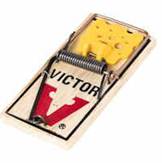 |
Victor Snap Traps - These traditional snap traps have an expanded trigger for those "picky eaters," and it allows you to use a greater range of baits. More surface area means you now have the ability to "smear" baits (such as peanut butter or chocolate) in thin layers for more positive catches. Traps placed across runways are tripped simply when the rodents walk across the pedals. |
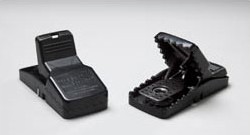 |
Trapper Mini T-Rex is a spring-loaded trap that's easy and safe to use. A state-of-the-art mechanical trap, it sets with one hand in one easy motion -- as easy as opening a clothespin.
Use Trapper Mini T-Rex alone or in pairs with the opening toward the wall. Mice enter from either the front or sides. Place the trap along walls where mice travel, in cupboards or wherever mice are present. Disposal is also easy. Simply pinch the two ends together to release the mouse and the trap is automatically reset to be used over and over again. |
Tips for Mouse Snap Traps
 |
Rodents enter a home through holes the size of a dime and run along walls, not over open spaces. |
1. Place mouse traps perpendicular to the wall.
2. Place mouse traps out unset for a few days so rodents can become familiar with it.
3. Place mouse traps where rodent activity is seen (sign of chewing, droppings, runway, and burrows).
4. Leave mouse traps undisturbed for at least two days before moving to a new location.
5. Check mouse traps daily and replace as needed.
6. Wear gloves when disposing of rodent.
| Glue Trays |
 |
Rat Glue Trays -Glue Boards capture rats and mice without poison. The glue boards are ideal to use in food plants, kitchens, restaurants, food processing plants, hospitals, residences, zoos and other sensitive areas where the use of poison is prohibited or discouraged. Once rodents step onto the glue board, the glue holds a rat securely, while just the slightest contact with the glue will hold a mouse. For best results, place Glue Boards directly in the rodent's runway between its nest and food supply -- every 8 to 12 feet for mice and 15 to 30 feet for rats.
Baiting
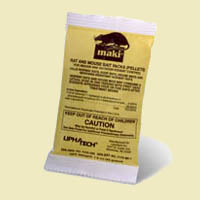 |
Maki Bait Packs - Maki pellets contain the world's most advanced single-feeding anticoagulant - Bromadiolone. Bait shyness is not a problem because a single low dose is most often lethal, producing dead rodents in an average of three to five days after treatment. Maki place packs are extremely effective against Norway (including Warfarin resistant), roof rats and house mice. It can be used in and around residential and commercial buildings. The labeled packs (each containing 1.5 ounces Maki pellets) are advantageous in areas where regular service access is difficult. |
| Contrac All-Weather Blox - is a multi-edged, single feeding rat and mouse bait, and has excellent rodent acceptance. It is colored blue for easy recognition as a non food item. |
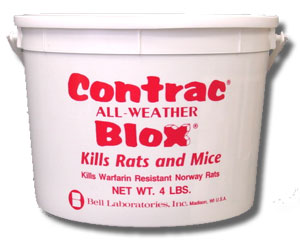 |
The 1 oz. bait pieces fit easily into b urrows, bait stations and tight fitting places. A hole through the center allows you to hang the bait on securing rods or pegs for extra safety.
|
Place Packs are EPA approved to control Rats, Mice, and Voles. Place Packs contain a grain bait that can be easily applied to a vole or rodent burrow. This bait is highly effective and less likely to result in secondary toxicity to non-target animals. Warfarin has been used in the rodent control industry for over 40 years and remains effective in handling all sorts of rodent control jobs. |
Rats: Place at least 2-8 packs per placement. Maintain an uninterrupted supply of fresh bait for 10 days or until signs of rat activity cease.
Rats and Mice : Immediately replace contaminated or spoiled bait. Properly collect and dispose of all visible dead animals and leftover bait. To discourage reinfestation, limit sources of rodent food, water and harborage as much as possible. If reinfestation occurs, repeat treatment. For a continuous infestation, set up permanent bait stations and replenish bait as needed.
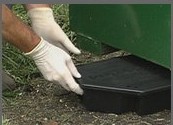 |
Bait Stations |
Protecta LP is a triangular shaped bait station that fits in corners and along walls where rodents travel. Excellent for outdoor baiting and it's "Low Profile" makes it ideal to use indoors under pallets and in other tight baiting locations. Protecta LP holds all types of bait, including Contrac Blox that fit on horizontal and vertical bait securing rods. Patented interior baffles lead rodents directly to bait. Protecta LP locks automatically when closed and unlocks with a special 2-prong key that also opens Protecta Mouse, and the Protecta RTU. Available in black, light gray and green to fit discreetly in any baiting environment. These stations are used extensively in industrial or food plant operations for exterior perimeter protection. They are also great for perimeter protection around the home or next to piles of firewood or excessive harborage areas. Whether you are in a rural area (mesas, mountains, woods) or in an urban environment, these stations will provide you with year round protection from foraging rodents. The ideal spacing for Protecta LP's range from 20 ft. to 50 ft. A lot of homes keep no less than four. One for each side of the house.
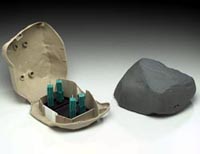 |
Protecta Landscape is a tamper resistant bait stations that looks like landscape rock that could be found in any natural setting to lend itself as part of the habitat. This unique feature allows the pest control operator to set the bait station where it needs to be rather than out of sight where it has to be so the esthetics of the landscape are not affected. Its low profile and its camouflaged entry points make it blend naturally into the surrounding landscape. Available in two realistic 'rock' colors, sandstone and granite, Protecta Landscape features a naturally textured surface for a realistic appearance. Protecta Landscape locks when closed and opens with the standard Bell 3-prong key. The one-piece liner and its side-opening design make servicing easy. Four vertical bait-securing rods hold eight 1 oz. Blox securely inside the station. Protecta Landscape also accommodates a Trapper T-Rex rat snap trap. Made of heavy-duty, injection-molded plastic, with a durable hinge built to withstand frequent servicing, Protecta Landscape offers the superior durability PMPs |
Sealants
| Pur Black is a awesome sealant foam that works great for outdoor applications. Pur Black is dispensed from a professional applicator straw that requires no gun - its economical size is great for medium sized projects and one time jobs. Perfect for blending in with an outdoor environment, and won't get a "dirty" appearance. You can also use this sealant in conjunction with Stuf-Fit for absolute exclusion of rodents, insects, or birds |
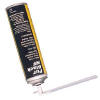 |
 |
IPF Foam offers a fast, economical and professional method to do the required sealing. IPF Foam will stop the passage of most insects, rodents, birds, and other small animals. It also has an added scent to deter these animals. IPF Foam is dispensed through the Pur Shooter Gun. This system assures professional placement of the exact amount of foam required to seal any gap. For added control, use it in conjunction with Stuf-Fit for absolute exclusion. |
|
|